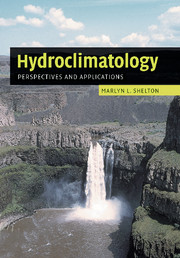Book contents
- Frontmatter
- Contents
- Preface
- 1 The realm of hydroclimatology
- 2 The climate system and the hydrologic cycle
- 3 Measuring hydroclimate atmospheric components
- 4 Measuring hydroclimate terrestrial components
- 5 Remote sensing and hydroclimate data
- 6 The runoff process and streamflow
- 7 Hydroclimate spatial variations
- 8 Hydroclimate temporal variations
- 9 Floods: the hydroclimatic extreme of excessive moisture
- 10 Drought: the hydroclimatic extreme of deficient moisture
- References
- Index
10 - Drought: the hydroclimatic extreme of deficient moisture
Published online by Cambridge University Press: 06 July 2010
- Frontmatter
- Contents
- Preface
- 1 The realm of hydroclimatology
- 2 The climate system and the hydrologic cycle
- 3 Measuring hydroclimate atmospheric components
- 4 Measuring hydroclimate terrestrial components
- 5 Remote sensing and hydroclimate data
- 6 The runoff process and streamflow
- 7 Hydroclimate spatial variations
- 8 Hydroclimate temporal variations
- 9 Floods: the hydroclimatic extreme of excessive moisture
- 10 Drought: the hydroclimatic extreme of deficient moisture
- References
- Index
Summary
Negative moisture anomalies
Drought is a naturally occurring phenomenon throughout most of the world, and it has tremendous damaging consequences for physical, economic, social, and political sectors of society (Woodhouse and Overpeck, 1998). The frequent and irregular occurrence of drought is a major reason for construction and management of water supply facilities in drought-prone areas because drought exacerbates natural limitations on water supplies. Unfortunately, drought duration, magnitude, severity, and recurrence remain difficult to forecast with precision (Loáiciga, 2005). Drought duration is the temporal component of the moisture deficiency, magnitude expresses the average deficiency, severity is the cumulative moisture deficiency, and recurrence is a probabilistic estimate of the next appearance of the moisture deficiency (Dracup and Kendall, 1990; Byun and Wilhite, 1999).
Drought is generally associated with low-frequency components of the climate system commonly related to SSTs or solar variability (Fye and Cleaveland, 2001; Hidalgo, 2004). Consequently, drought is a synthesis of two sets of processes. The first set is clearly related to the delivery of precipitation through climate of the first kind and the atmospheric branch of the hydrologic cycle. The second set of processes involves how precipitation is treated at the Earth–atmosphere interface, and this is the realm of climate of the second kind and the terrestrial branch of the hydrologic cycle.
Drought occupies the opposite extreme of floods on the hydroclimatic continuum. Negative moisture anomalies or water deficit are the central concept in defining drought, while floods are associated with positive moisture anomalies.
- Type
- Chapter
- Information
- HydroclimatologyPerspectives and Applications, pp. 344 - 382Publisher: Cambridge University PressPrint publication year: 2008

